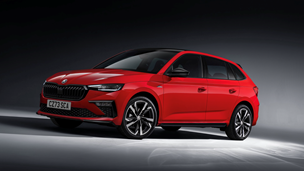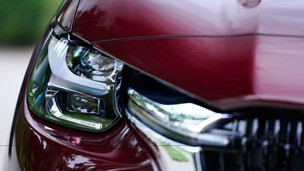Self-lacing shoes, food hydrators, hoverboards… There’s an endless list of things the time-travelling classics that make up the Back to the Future trilogy made us wish we had.
Top of the list? That iconic DeLorean time machine, of course. Without a shred of doubt, the DeLorean DMC-12 is one of the highlights of the series and one of the most instantly recognisable cars in history.
With its distinctive gullwing doors and space-age design, the car was the obvious choice for Doc Brown in the movies, who built the car over the course of nearly thirty years, using almost all of his family fortune to fulfil his vision of a vehicle able to travel through time.
After coming up with the concept of the time travel-enabling flux capacitor, Doc moved into his garage and constructed the time machine device, before fitting it to the DeLorean sports car in 1985 and originally using plutonium to power it.
Throughout the films, the operation of the DeLorean time machine is essentially the same. The operator sits inside the car and turns on its time circuits, before dialling in a target date to travel to using the seven-segment displays.
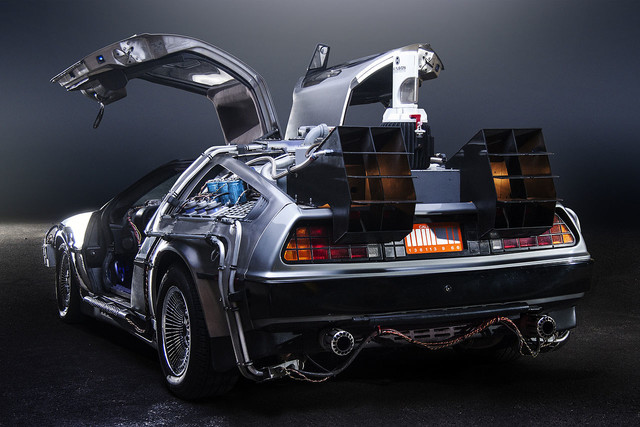
After entering the correct date, the driver then accelerates the car to 88mph, which activates the flux capacitor and several Tesla coil-style devices which surround the body. Surrounded by electrical current, the car then vanishes in a flash of light, leaving just a pair of flaming trails where the tyres will arrive at the destination time.
Passengers inside the vehicle see only a quick flash of light before instantaneously arriving at the target time, and after the trip the exterior of the car is left extremely cold, with frost forming from atmospheric moisture across its body.
Although the real DeLorean DMC-12 was powered by a 2.8-litre Peugeot-Renault-Volvo V6, Doc Brown’s time machine is electric. Requiring the use of a miniature nuclear reactor to generate the 1.21 gigawatts of power needed to operate its time circuits, it produces power roughly equivalent to that of 15 regular jet engines.
Originally, the car is powered by a plutonium reactor and later by a lightning strike, but afterwards gets replaced with a Mr Fusion Home Energy Reactor when Doc returns from 2015. The reactor, which was a parody of the Mr Coffee machines that were popular at the time of filming, converts household rubbish into power via cold fusion and allows the characters to bypass the arduous requirements of the first movie.
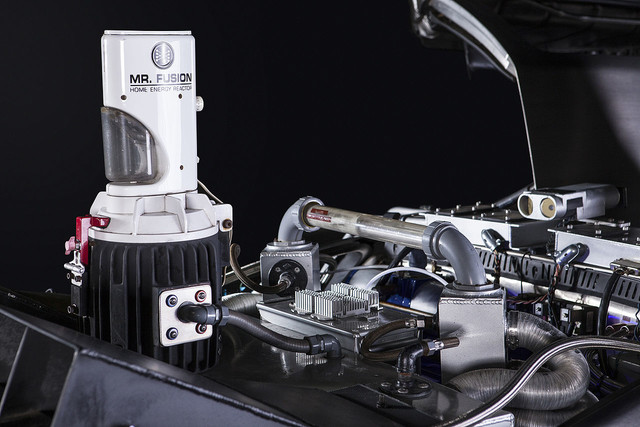
Able to provide enough power to send the car back in time, the Mr Fusion system also powers the hover system and is able to reach the necessary 88mph required for travel. However, when the flight systems are disabled as a result of a lightning strike and Doc and Marty end up stuck in 1885 in the third film, the pair are forced to rely on the original engine.
Unfortunately, the car’s fuel line is in turn damaged, meaning that Doc and Marty have to push the car with the help of a steam locomotive to reach the 88mph required to activate the time circuits and travel back to the present.
Key to the time machine’s operation is the flux capacitor, Doc Brown’s greatest invention. Conceived on November 5th, 1955, when Doc slipped on the toilet and hit his head while hanging a clock in his bathroom, the vision of the flux capacitor came to him when he awoke.
Consisting of three flashing Geissler-style tubes arranged in a Y configuration, the flux capacitor is the key component which makes time travel possible. As the car nears 88mph, light coming from the flux capacitor begins pulsing more rapidly until it becomes a steady stream and the time machine disappears into the space-time continuum.
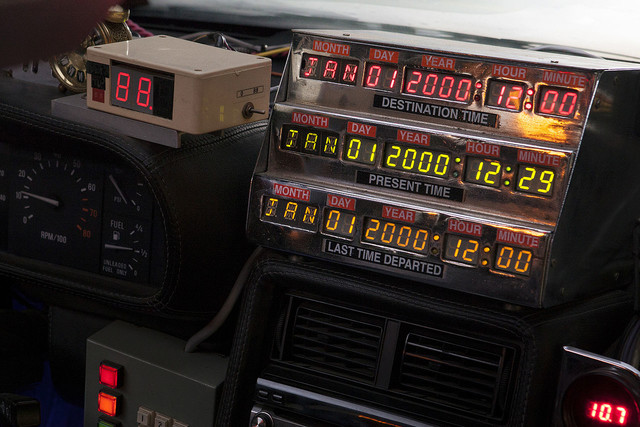
It’s never explained exactly how the device works in the films, though Doc mentions at one point that the stainless steel body of the DeLorean has a direct and influential effect on it, improving the “flux dispersal” and allowing the vehicle smooth passage through time and space.
In real life, what would eventually end up as the time machine in the film first went through several variations during production. In the first draft, the time machine was actually a laser device that was housed inside a fridge. Director Robert Zemeckis later said that the idea was scrapped to prevent children climbing into fridges and getting stuck inside.
By the time the third draft was completed, the writers had decided that the time machine would be a car, with the DeLorean DMC-12 chosen specifically because it looked “like an alien spaceship”, according to the director.
Once the filmmakers decided upon the DeLorean, the art department was instructed to come up with designs for the car, with the brief specifying that it had to look like something that had been bolted together in Doc Brown’s garage. Ron Cobb was the artist assigned to the job, complementing the DMC-12’s already futuristic look with coils at the rear and vents for the nuclear reactor.
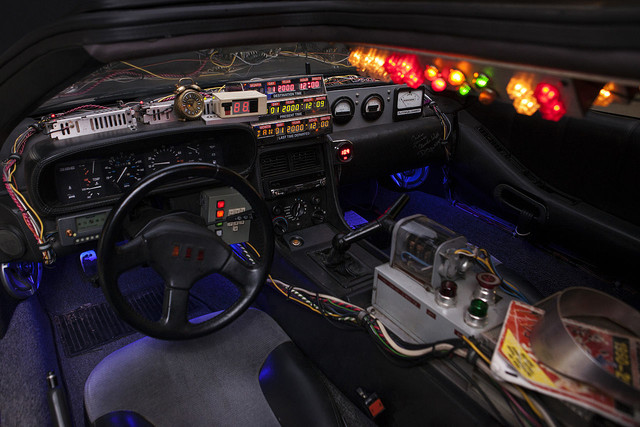
These design flairs proved to be ultimately important to the direction of the series, as by the end of the first film the vents became the propulsion system for the upgraded DeLorean, which now had hovering abilities. Final touches added by the production design team included various buttons, dials and lights inside to make the interior look more complex and appealing, similar to how the computers in Star Trek were made specifically to appear futuristic and hard to use.
Ultimately, five real DeLoreans were used throughout the filming of the trilogy, with three used in the first film alone. For the off-road scenes in the third movie, a Volkswagen Baja Bug frame was used as an underpinning for the car’s shell, with whitewall tyres and baby moon wheels added.
Liquid nitrogen was poured onto the car for scenes after it had travelled through time in order to give the impression it was cold, while in one of the first scenes, the film crew hooked up fire extinguishers to the rear in order to simulate the exhaust effect.
Despite the fact that the DeLorean needs to reach 88mph in order to travel through time, all variations of the real DMC-12 destined for America had speedometers that only read up to 85 miles per hour.
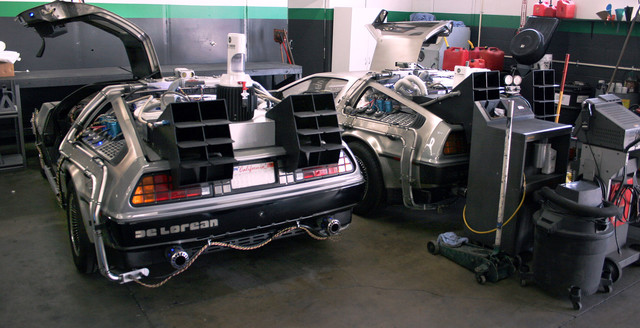
A law from Jimmy Carter’s administration stated that car speedometers could read no higher than 85mph, based on the belief that if people couldn’t read speeds higher than that, they wouldn’t drive any faster. As a result, all of the film cars had modified instrument clusters installed, with speedos that read up to 95.
The time machine’s licence plate in the film reads “OUTATIME”, a deliberate anomaly as the maximum number of symbols allowed on a Californian plate is only seven. Also, when Doc returns from 2015, the license plate has been replaced with a barcode, implying that by now licence plates would have moved to more sophisticated means of registration.
Of course, that isn’t quite the case. Licence plates are still strictly character-based, and despite the best efforts of Lexus, real hoverboards essentially remain a pipe dream. Roads? Where we’re going we… Wait yeah, actually we do still need roads as well.
Still, whether or not everything the films predicted came true, it’s fitting that, thanks to its role as the world’s best-loved time-travelling car, the DeLorean DMC-12 now remains principally timeless.
